Vroom! Into the graveyard of Vespas we rode...
 |
I was at my apartment in Clifton, waiting for a friend. He did not show up on time, so I rang him up. My friend told me that he was here but the apartment chowkidar was not letting his Vespa enter the compound.
I went downstairs and resolved the matter. Climbing up the stairs, I asked my friend Wali where he had bought it from, and he told me that he bought it from a dealer in the Tyre Market on M.A. Jinnah Road. He said that it was Piaggio Vespa’s 1968 model, but that he intended to buy another ‘62 model Vespa.
We sat down to discuss work, but my mind was still stuck on the Vespa. Finally I cut him short and blurted out:
“I want to buy one too.”
“Great decision!” Wali said. “What’s that saying ... a four-wheeler transports the body, while a two-wheeler transports the soul.”
He went into detail, explaining how the rider of a two-wheeler is somehow more connected with his vehicle and the surroundings, which the driver of a four-wheeler could never understand.
Of course, all that philosophy went way over my head. I clarified my intentions to him:
“I want to buy it without an engine. As a showpiece, for my lounge”, I said.
There was a brief silence in the room.
“Still a great decision; but you should buy one with proper documentation and engine, you never know when you might need to sell it,” Wali said.
It was a Friday evening and we decided to embark on a Vespa hunt the day after.
On the hunt for a Vespa
We drove towards the Tyre Market and parked our car somewhere near Urdu Bazaar. Wali knew a Vespa mechanic, Shehzad, who was also the proud owner of a 1983 model Vespa. He had painted it pink and installed two speakers below the handle. The seats of his Vespa and the spare tyre cover had pink leather covers too.
Shehzad took us to the shops around, where we found various Vespas in different conditions. Wali began to inquire about a ‘62 model from the vendors. Someone from an auto-parts shop overheard our conversation and told us that he had one at his home, but could only bring it on Monday.
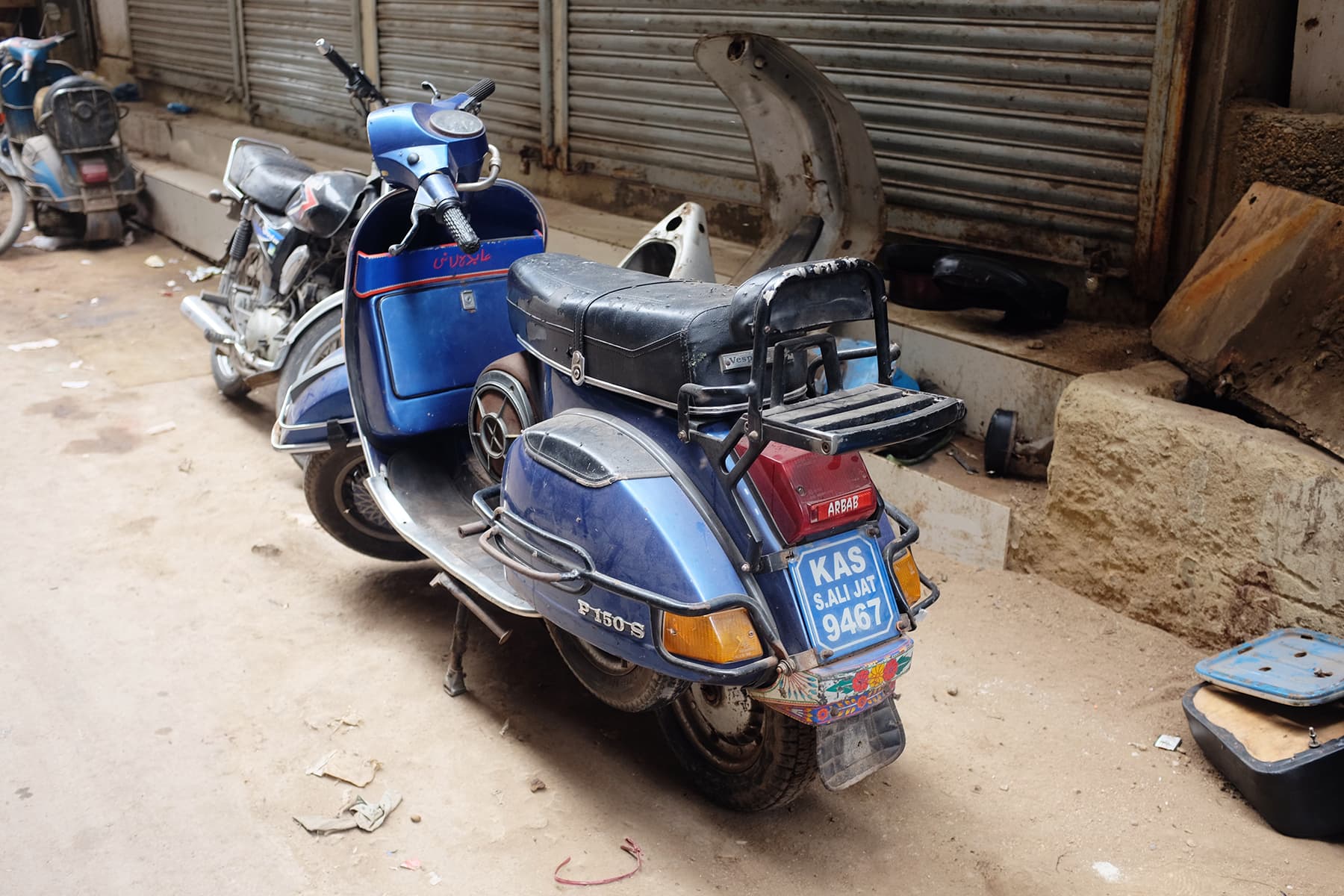 |
| Shehzad shows us different Vespas near his workshop. |
 |
| Wali negotiates the price with a mechanic. |
 |
| An operational Vespa. |
 |
| A ‘68 Model Vespa on display. |
 |
| Vespas undergoing refurbishment. |
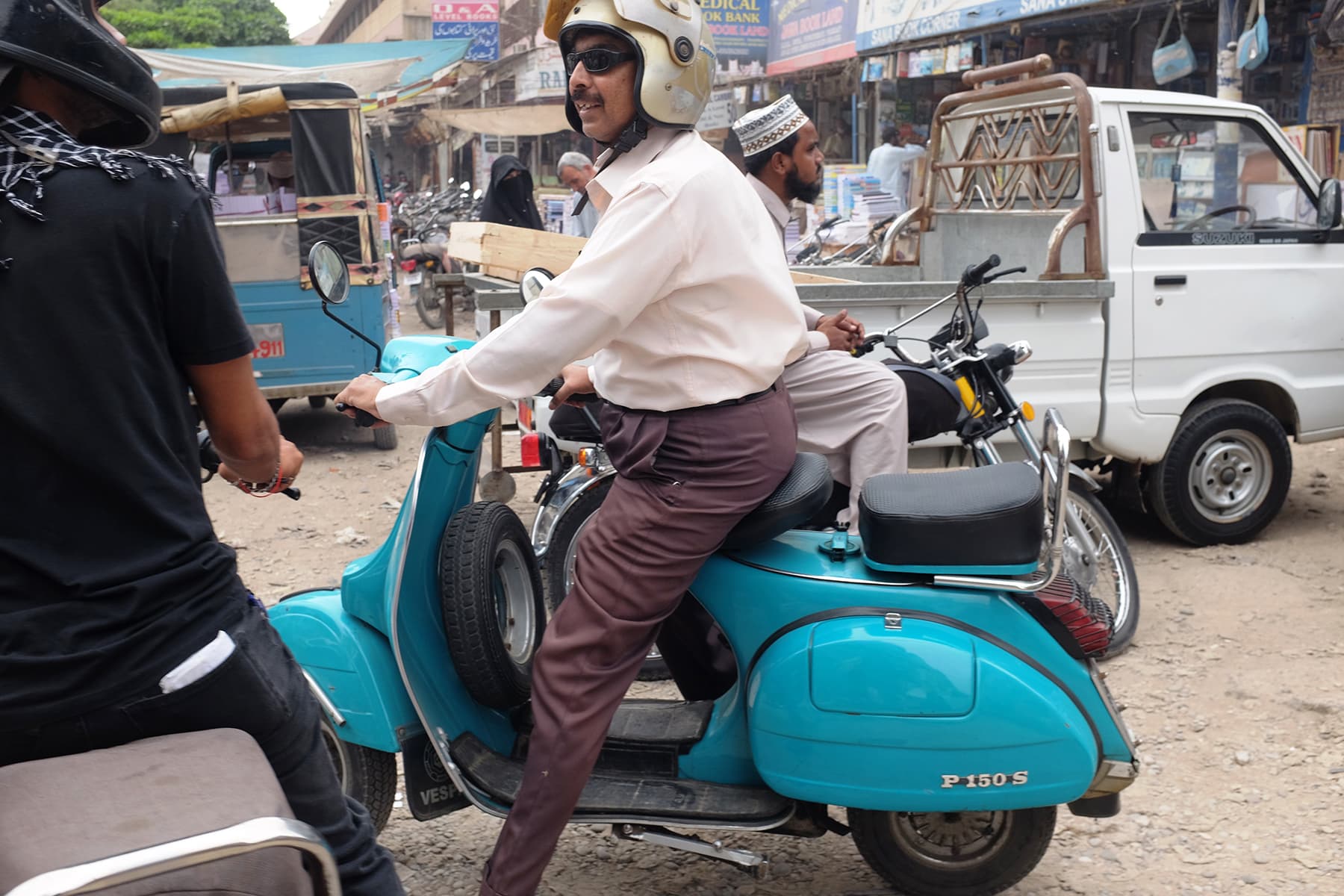 |
| We spot a lot of people going about their business in Vespas. |
 |
| A Vespa skeleton ready for refurbishment. |
 |
| Shehzad poses with his pink ‘83 model Vespa. |
Wali later told me that most of these Vespas were spread across different locations, waiting on consideration from vendors for refurbishment before they could be put on display for sale. We could not afford to go too far to check out just one Vespa, so Shehzad suggested that we visit the dealer with the largest collection in the area. I asked him if we could walk, but he asked us to take a ride on his Vespa.
“All three of us?” I was hesitant.
Shehzad and Wali ignored my concern and had already settled on the Vespa. I squeezed in somehow between Wali and a spare tyre, and vrooom we went.
Also read: Men and their motorcycles
We rode down Burns Road. Wali spotted a few Vespa riders along the way and it made him immensely happy. At one of the signals, Wali spotted an aquarium shop and asked Shehzad to make a stop. He told me that he had bought a pet snake and needed an aquarium for it, a rather basic one without all the fancy fixtures of a fish aquarium. We inspected various aquariums but failed to reach a consensus with the shopkeeper on the price.
Resuming our journey, a few more twists and turns took us to a shop tucked between auto repair shops, off M.A. Jinnah road. Abdullah bhai, the dealer, had stuffed his shop with various Vespa models. He seemed to have just opened the shop for the day, and a helper was taking the bikes out to put them on display.
 |
| Various models of Vespas inside Abdullah's showroom. |
 |
| Abdullah's showroom. |
 |
| A Vespa with truck art at Abdullah's shworoom. |
 |
| Abdullah has one of the largest collection of Vespas in the city. |
 |
| People have customised their Vespas according to their liking. |
 |
| A ‘70s model Vespa repainted in black. |
 |
| As we negotiate with Abdullah, a helper starts taking Vespas out on display. |
 |
| An old Piaggio poster. |
Wali, Shehzad and Abdullah bhai engaged in an exhausting negotiation, which shifted from one model of the Vespa to another. Wali asked me if I liked any in particular, and I told him that I loved all of them but I couldn’t picture any in a finished state.
Wali told me that the prices are a little jacked up, perhaps due to the fact that a lot of foreigners and affluent collectors have started taking an interest in vintage models, and some have even started exporting them to Italy and beyond after refurbishment.
 |
| The negotiation shifts from one model to another. |
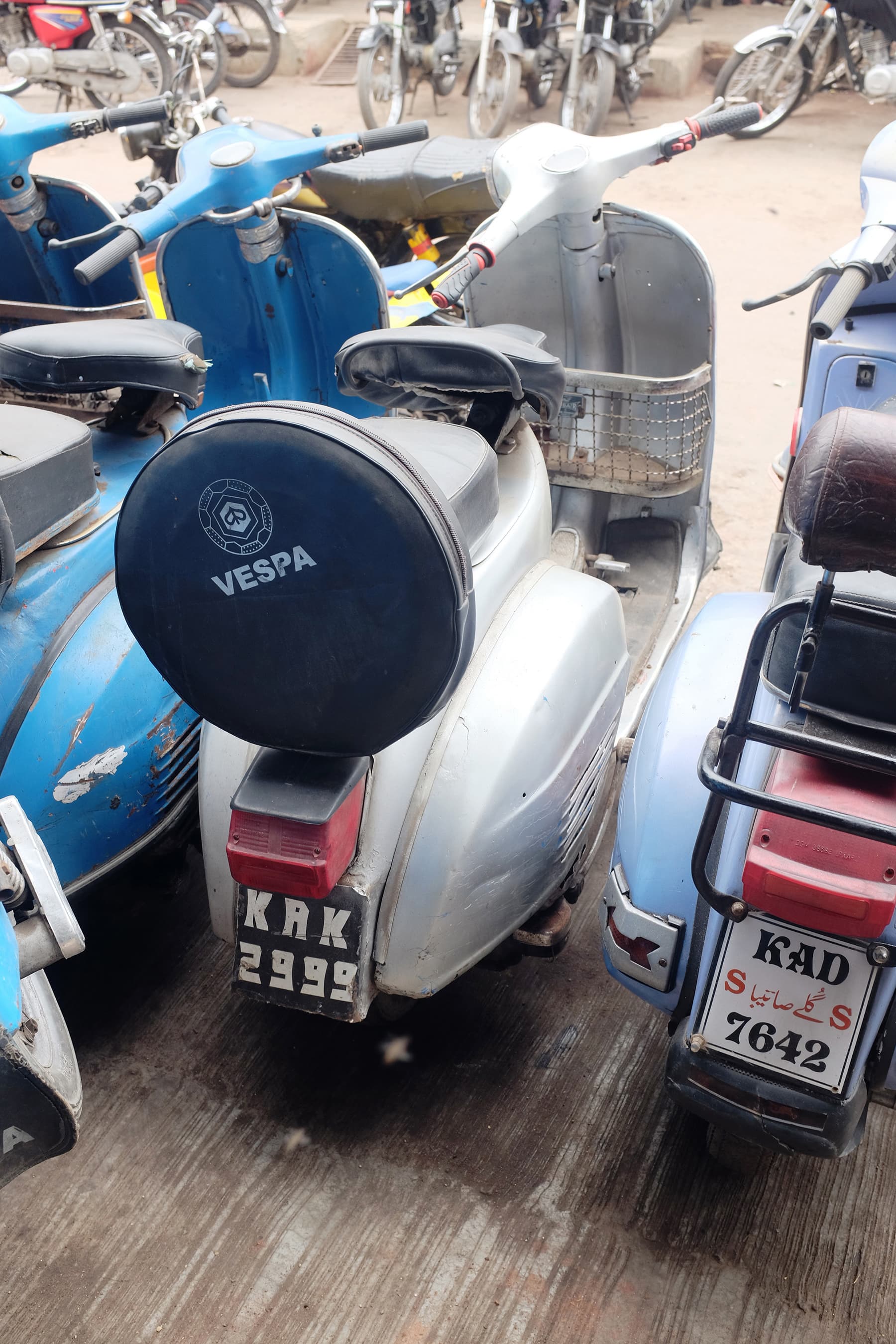 |
| A Vespa repainted in silver. |
 |
| We bid farewell to Abdullah and start our journey to Ranchor lines. |
We walked out of Abdullah bhai’s shop when someone mentioned that Tahir mistri (mason) in Ranchor Lines had a larger collection, but that most of his Vespas were in a dire condition and would require a lot of re-hauling. We decided to pay him a visit.
Crossing M.A. Jinnah road, we took a route through the flower vendor market in the Eid Gah area. Shehzad was manoeuvring his Vespa expertly, though I feared for my legs, which were dangling from the back seat. We crossed Bohra Pir and finally pulled over in a narrow street full of auto repair shops.
Tahir Mistri’s shop was at the end of the street. We walked towards it and told Tahir that we needed a ‘62 model. He took us through another narrow but rather dimly lit lane, which looked like a graveyard of Vespas. Somebody told me that here, you could find all the parts of any vintage model.
 |
| Most of the Vespas in Ranchor lines are waiting for refurbishment. |
 |
| The street is full of auto repair shops. |
 |
| The proud mechanic tells me that he has restored this CD50. |
 |
| A Vespa waiting in line for refurbishment. |
 |
| A mechanic repairs a Vespa. |
 |
| We spot a ‘62 Model! |
In this heap of ancient machinery, we found a ‘62 model Vespa. Tahir told us that he could get it restored to to an impeccable condition should we decide to buy it. He further said that he had a few vintage Vespas parked in Hyderabad, which we were welcome to check if we were willing to accompany him to Hyderabad the next day. We looked at each other, but then decided against it.
As we stepped out of the shop. Wali and Shehzad engaged in a debate on the merits of purchasing the ‘62 model from Tahir Mistri. Finally they decided to wait until he brought the rest of the models from Hyderabad.
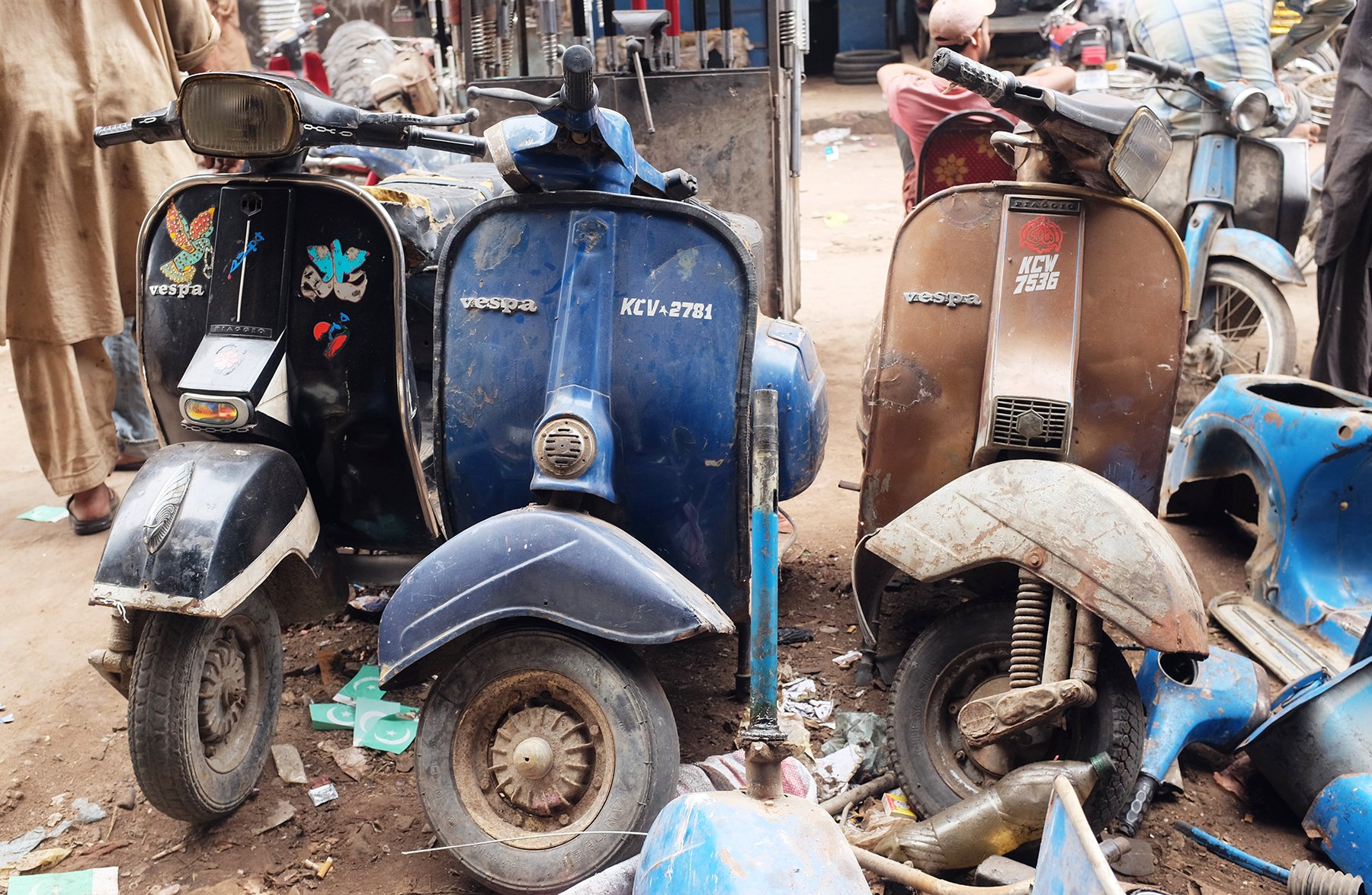 |
| An assortment of colorful Vespas. |
 |
| The narrow lane looks like a graveyard of Vespas and its spare parts. |
 |
| A mechanic looks on. |
 |
| Tahir mistri is an expert at repairing Vespas. |
 |
| After negotiations, we break for lunch at a roadside nihari walla. |
Wali announced that he was hungry and we should break for lunch. Shehzad said that there was a nihari shop nearby which served the best nihari in town. We all agreed instantly – a first for the day.
At the nihari shop, quite a few workers were sitting on benches, having lunch. We squeezed in on one of the benches and ordered a plate of nihari and 'chanay ki daal'. We finished our meals in minutes and asked Shehzad to ride us back to our car.
As soon as we reached M.A. Jinnah road again, I spotted cane shops on my left and told Wali that I needed a few cane blinds for my house. We got off the Vespa and bid farewell to Shehzad, who drove straight to his shop.
Wali already knew the shopkeeper, Mehboob, who made blinds at a very reasonable rate. His shop is at the start of a small street off M.A. Jinnah Road. While we placed the order with Mehboob, I noticed a stone gate tucked between new cement constructions. There was a plaque installed on the top. I left Wali and Mehboob deep into bargaining and walked towards it. It read:
“This Dharamshala for poor travelers was built at the joint cost of Haji Mahammad Moledina and the Karachi Municipality, 1983, J. Strachan M.I.C.E, Architect.”
A Dharamshala, that too built by James Strachan, one of the eminent architects of his time, who has landmarks such as the Merewether Tower, the DJ Science College, Karachi’s first sewerage system and many others to his credit.
Also read: Mr Strachan and Maulana Wafaai
 |
| Mehboob who has tiny shop for cane blinds speaks with a fellow worker. |
 |
| The plaque on the 'musafir khana'. |
 |
| View from Mehboob's roadside stall. |
 |
| An assortment of cane blinds. |
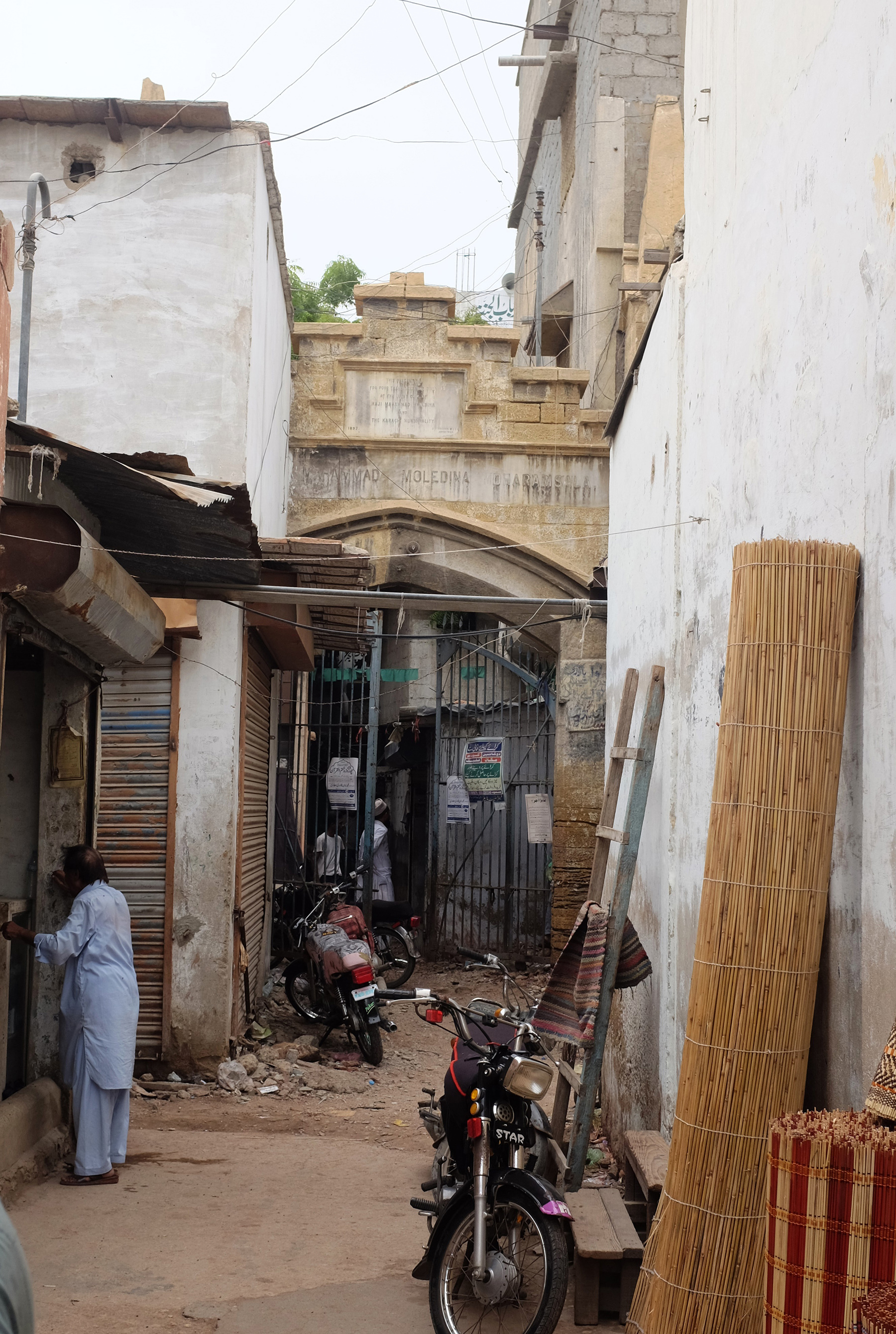 |
| As Wali and Mehboob negotiate, I spot an anomaly in the cement-built landscape. |
Mehboob told me that there used to be a musafir khana (rest house) here, which had been demolished to pave way for constructing more dwellings for people.
“And what about the poor travelers,” I wondered aloud.
Mehboob shrugs his shoulder. In city a where most of the citizens struggle to find reasonably priced accommodation, not much thought is spared for the poor travelers. The musafir khana is gone, but the shopkeepers around the area still use it in their verbatim when giving out directions.
We decided to drive back home and get in our car. Wali and I could not decide on the Vespa, but in the process we had learnt a little more about the city.
— All photos by author


